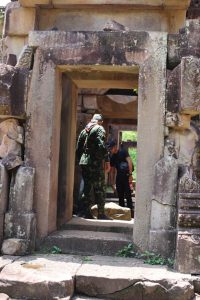A small gesture holds a glimmer of hope for a more lasting peace on a troubled border, reports Marnie Feneley
On a recent field trip shooting panoramic photographs at Banteay Chhmar, a temple in northern Cambodia, we decided to take a detour further north to see a temple known as Ta Muen Thom.
This temple, built in the 11th century, has ancient spiritual foundations, and I was interested to photograph the natural stone lingam in the northern tower and the inscribed yoni symbol on the natural rocks outside the main structure.
Ta Muen Thom, along with the more famous and spectacular clifftop border temple, Prah Vihear, have long been the subject of territorial disputes between the Thai and the Cambodians. In medieval times, the Khmer Empire reached as far as northern Thailand, and the Dangrek Ranges, which now mark the border with Thailand, were then in the centre of this vast empire until its demise sometime in the 14th century. Prah Vihear was an important pilgrimage site, and had contributions and modifications made to it by many Khmer kings.
Prasat Ta Muen Thom and its two related structures, Ta Muen Toch and Ta Muen, are small but important shrines because they mark the ancient royal pass across the Dangrek Range from Phimai to Angkor. Ta Muen Thom more so perhaps due to its fresh spring, which runs just below the entrance and may have been a source of water for travellers.
In 1904, the French, colonial occupiers of Cambodia at that time, set the country’s border with Thailand on top of the Dangrek Range, stranding Preah Vihear and Ta Muen Thom on the Thai side, but a map drawn up in 1907 situated them on the Cambodian side of the border.
When the French left Cambodia, the Thai forces moved quickly to occupy both temples and the surrounding areas. It was only after an international court ruling in 1962 found that the temples belonged to the Cambodians that the Thai army withdrew from the contested territories. Both Preah Vihear and Ta Muen Thom became strongholds for the remnants of the Khmer Rouge in the 1980s, and were the subject of extensive damage from both fighting and looting. The bullet holes seen sporadically in the walls of Preah Vihear attest to years of fighting.
Border clashes
In 2001, the Thai government blocked access to Preah Vihear for over 12 months. In 2008, Preah Vihear was declared a UNESCO world heritage site. Nevertheless, border clashes occurred in October 2008, April 2009 and again in 2011.
In the jeep with us was one of the toughest looking soldiers, incongruously holding a large, pink, sparkly hamper filled with delicacies
As we approached Ta Muen Thom temple, smart, new government houses spaced evenly across the landscape marked the presence of the Cambodian military, a stark contrast with the irregular wooden houses owned by the local farmers.
At the base of the hill on which the temple stood, it became obvious we had entered a military zone, with many uniformed soldiers and military vehicles. The landscape had quickly changed from agricultural lowlands to the thick forest of the mountains.
Our guide jumped out of the car and came running back with the news that ‘the General’ had said we could get a lift up the very steep pass to the temple in his jeep. Cameras and tripods in hand, we piled into the back of the black jeep to ascend the steep slope. In the jeep with us was one of the toughest looking soldiers, incongruously holding a large, pink, sparkly hamper filled with delicacies. We found later that this was a gift for the Thai Army general at the border from the Cambodian Army general.
When we arrived at the summit, we walked through what was a military camp, with sandbags, camouflage, machine gun nests, bunkers and collections of exploded shells from previous conflicts lining the walkway to the temple.
Shiva worship

Situated in the dense forest, steep laterite steps led to the remnants of the small temple composed of red laterite, surrounded by two small external towers, which had been almost completely destroyed. The Khmer Rouge had used dynamite to loot the carvings and decorative features of the temple, which are all but gone. A damaged sculpture of the sacred bull, called Nandin, the mount of Shiva is placed in the temple in front of a rare natural stone lingam, all indicators of the worship of the god Shiva at this site.
The god Shiva is traditionally [ratina][/ratina]associated with mountains, forests and wilderness areas. Shiva is also the god who brings about destruction in order for renewal to take place. It seems therefore appropriate that a contemporary ceremony for the renewal of peace in the New Year occurred in this particular temple in front of a natural stone lingam.
The elaborate gift carried by the soldier up the steep pass was given to the Thai general by the Cambodian general, in exchange for an equally elaborate gift in return, in a friendly ceremony witnessed by army personnel from both sides, who took many photographs.
This presentation marked the April New Year celebrations, a celebratory period shared in the Thai and Cambodian calendars. The Cambodian general confided afterwards that he was very happy to be supporting the peace at the border, but it all depended on the governments of the two countries to continue to maintain strong relations across the border.
In uncertain political times in Cambodia and Thailand, this was a positive story of peace at their border at the beginning of a new year.
Featured image
The exchange of gifts between the Thai general and the Cambodian general, in a friendly ceremony, was witnessed by army personnel from both sides, who took many photographs. Photo: Marnie Feneley

